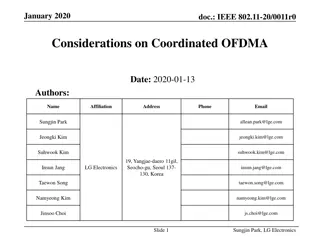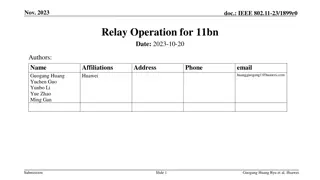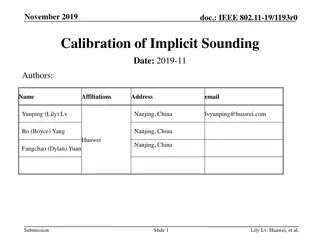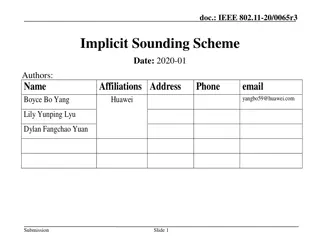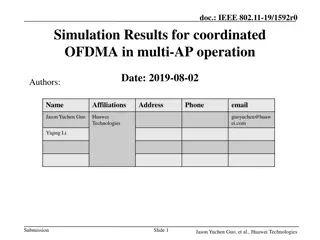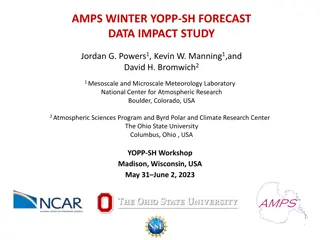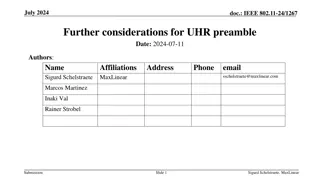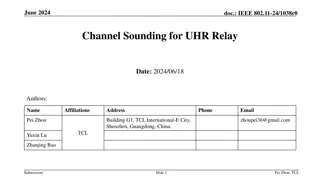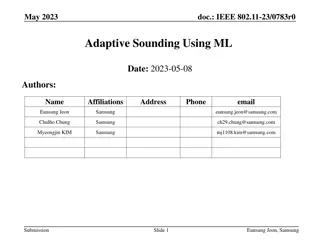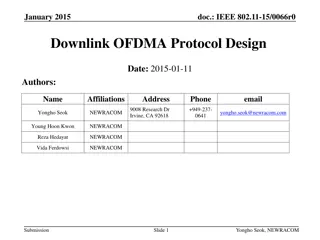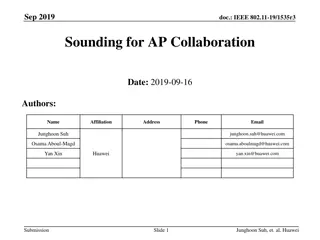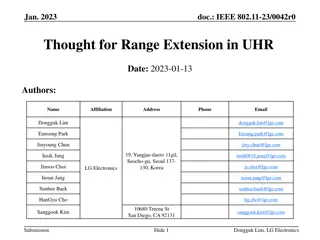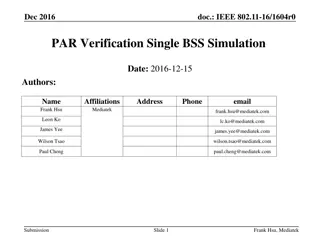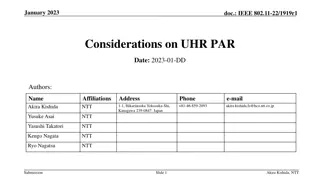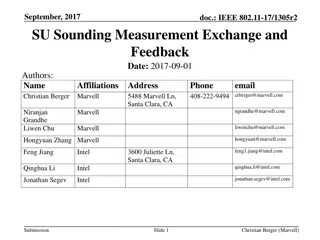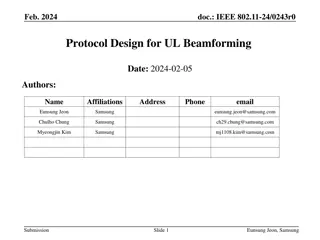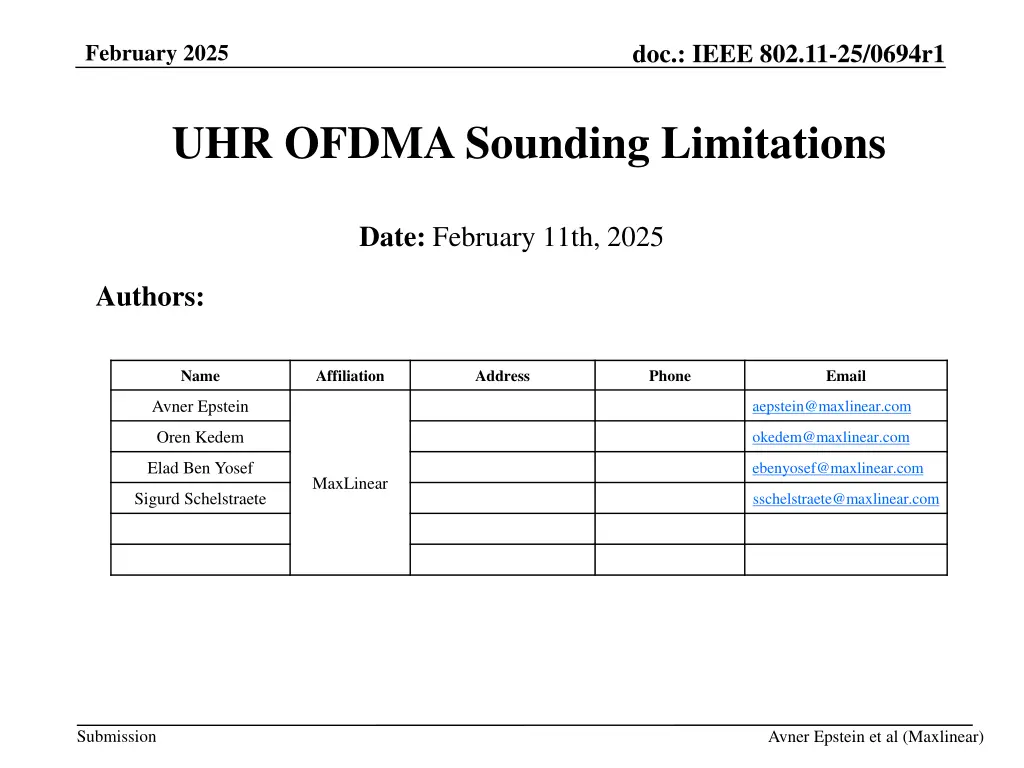
Efficient Support for MU-MIMO and OFDMA in UHR
Explore the limitations in MU-MIMO and OFDMA support in IEEE 802.11-25/0694r1 document for February 2025. Learn about the challenges in the sounding procedure and puncturing schemes, and the need for enhancements to efficiently support these technologies in UHR environment.
Download Presentation

Please find below an Image/Link to download the presentation.
The content on the website is provided AS IS for your information and personal use only. It may not be sold, licensed, or shared on other websites without obtaining consent from the author. If you encounter any issues during the download, it is possible that the publisher has removed the file from their server.
You are allowed to download the files provided on this website for personal or commercial use, subject to the condition that they are used lawfully. All files are the property of their respective owners.
The content on the website is provided AS IS for your information and personal use only. It may not be sold, licensed, or shared on other websites without obtaining consent from the author.
E N D
Presentation Transcript
doc.: IEEE 802.11-25/0694r1 February 2025 UHR OFDMA Sounding Limitations Date: February 11th, 2025 Authors: Name Affiliation Address Phone Email Avner Epstein aepstein@maxlinear.com Oren Kedem okedem@maxlinear.com Elad Ben Yosef ebenyosef@maxlinear.com MaxLinear Sigurd Schelstraete sschelstraete@maxlinear.com Submission Avner Epstein et al (Maxlinear)
doc.: IEEE 802.11-25/0694r1 February 2025 Introduction EHT Sounding provides inherent support for (static) preamble puncturing; however, it includes some inherent inefficiencies as described in [1]. UHR introduces renewed interest in MU-MIMO in an OFDMA PPDU Note: referred to as Partial Bandwidth MU-MIMO in 802.11be spec In this contribution we describe how the sounding inefficiencies, that stem from the original definition of 11be, impact MU-MIMO + OFDMA in UHR. Further enhancements will need to be introduced into UHR Sounding Procedure in order to efficiently support MU-MIMO + OFDMA. Submission Avner Epstein et al (Maxlinear) Slide 2
doc.: IEEE 802.11-25/0694r1 February 2025 EHT Sounding Reminder The sounding procedure, defined in the 802.11be spec, consists of multiple frames, as depicted in the following diagram: Note: a STA may be requested by the AP to provide a partial BW report, in granularity of either 20MHz/40MHz for 160MHz/320MHz NDP BW, respectively. Submission Avner Epstein et al (Maxlinear) Slide 3
doc.: IEEE 802.11-25/0694r1 February 2025 EHT Puncturing Reminder The 802.11be spec defines the following puncturing schemes: EHT MU (non-OFDMA) has 45 supported patterns that correspond to non-OFDMA Large MRUs, defined by the 5-bit punctured channel indication in the U-SIG field See Table 36-30 EHT MU (OFDMA) any one of 7 puncturing patterns is supported for each 80MHz subblock ( 0111 , 1011 , 1101 , 1110 , 0011 , 1001 , 1100 ) by using 4 of 5 bits of the punctured channel indication in the U-SIG field Note: every non-OFDMA puncturing pattern is also regarded as an OFDMA puncturing pattern, but not vice versa. An AP uses the Disabled Subchannel Bitmap in the EHT Operation Element to indicate to all STAs which subchannels should not be used for any PPDU exchanges on this operating channel in this EHT BSS The Disabled Subchannel Bitmap shall correspond to one of the non-OFDMA puncturing patterns See 35.15.2 An AP may puncture other subchannels in addition to those indicated in the Disabled Subchannel Bitmap in a DL PPDU, provided that the AP s transmission carries a triggering frame that solicits a TB PPDU from any responding STAs No additional puncturing allowed in frames that expect immediate response Submission Avner Epstein et al (Maxlinear) Slide 4
doc.: IEEE 802.11-25/0694r1 February 2025 Static vs. Dynamic Puncturing For clearer explanation of the problem, we would like to introduce the following concepts: Static Puncturing: only subchannels indicated as being punctured in the Disabled Subchannel Bitmap in the EHT Operation Element (i.e. having a value of 1 ); as such, this puncturing pattern must conform with Non-OFDMA puncturing. Dynamic Puncturing: subchannels indicated as not being punctured in the Disabled Subchannel Bitmap in the EHT Operation Element (i.e. having a value of 0 ), may be punctured by the AP (in addition to the Static Puncturing) due to dynamic interference based on CCA within the current TXOP. The combined Static+Dynamic Puncturing must conform to either OFDMA or non- OFDMA puncturing, depending on the DL PPDU. OFDMA puncturing which does not also conform to non-OFDMA puncturing pattern is only allowed in an OFDMA PPDU. Hereby an example of dynamic OFDMA puncturing: 320MHz 20P DYNAMIC PUNCTURING STATIC PUNCTURING Submission Avner Epstein et al (Maxlinear) Slide 5
doc.: IEEE 802.11-25/0694r1 February 2025 MU-MIMO in OFDMA and Sounding Supporting MU-MIMO on one or more RUs in an OFDMA PPDU exist since 11ax but is not utilized In [2], a set of combinations of OFDMA+MU-MIMO are proposed for 11bn for getting better vendor adoption As opposed to OFDMA, DL MU-MIMO highly benefits from a fresh sounding prior to any Data sequence. The inherent limitations of EHT Sounding may make MU-MIMO in OFDMA unusable under certain conditions, as will be explained in the next slides. Submission Avner Epstein et al (Maxlinear) Slide 6
doc.: IEEE 802.11-25/0694r1 February 2025 Problem Statement The following example shows a 160MHz PPDU with the following RUs: RU#1: 996 tone RU designated for DL MU-MIMO RU#2: 484+242 tone RU designated for DL MU-MIMO (20 MHz removed due to static puncturing) Due to Busy Medium, also RU#1 needs to be punctured (and reduced to 484+242) This is permitted according to EHT OFDMA puncturing; however, this configuration cannot be sounded, since NDP must conform to Non-OFDMA puncturing. Hence, the AP must fall back to one of the following options: Utilize the entire 160MHz (punctured) for OFDMA only without fresh sounding Reduce the BW to 80MHz (punctured) to allow Full BW MU-MIMO with fresh sounding 160MHz RU#1 for DL MU-MIMO DYNAMIC PUNCTURING RU#2 for DL MU-MIMO STATIC PUNCTURING Submission Avner Epstein et al (Maxlinear) Slide 7
doc.: IEEE 802.11-25/0694r1 February 2025 Problem Statement (2) The following example shows a 320MHz PPDU with the following RUs: RU#1: 2x996 tone RU designated for DL MU-MIMO RU#2: 996+484 tone RU designated for DL MU-MIMO (40 MHz removed due to static puncturing) Assume that the upper 20MHz subchannel of RU#1 has interference, hence RU#1 also needs to be punctured; however, since the partial BW info field in NDPA is limited to 40MHz granularity, RU#1 must be reduced to 996+484 This is permitted according to EHT OFDMA puncturing; however, similar to the 160MHz example, this configuration cannot be sounded, since NDP must conform to Non-OFDMA puncturing. Hence, the AP must fall back to one of the following options: Utilize the entire 320MHz (punctured) for OFDMA only without fresh sounding Reduce the BW to 160MHz (punctured) to allow Full BW MU-MIMO with fresh sounding 320MHz RU#1 for DL MU-MIMO DYNAMIC PUNCTURING RU#3 for DL MU-MIMO STATIC PUNCTURING Submission Avner Epstein et al (Maxlinear) Slide 8
doc.: IEEE 802.11-25/0694r1 February 2025 Conclusions We described how the fact that EHT NDP must conform to Non-OFDMA puncturing severely restricts the employment of MU-MIMO in OFDMA. This limitation may also reduce the attractiveness of DSO, which is also planned for UHR. It is our view that 802.11bn should address this issue by designating UHR NDP as an OFDMA PPDU. Specifically, enabling the puncturing available in OFDMA PPDUs Submission Avner Epstein et al (Maxlinear) Slide 9
doc.: IEEE 802.11-25/0694r1 February 2025 SP Do you agree that UHR NDP should support the puncturing available in OFDMA PPDU, in order to enable a fresh sounding for Partial BW DL MU- MIMO with dynamic interference? Yes / No / Abstain Submission Avner Epstein et al (Maxlinear) Slide 10
doc.: IEEE 802.11-25/0694r1 February 2025 References [1] 21/1778: EHT Sounding Enhancements [2] 24/1827: On OFDMA and MU-MIMO Submission Avner Epstein et al (Maxlinear) Slide 11


